A small seed fern stem with peculiar
structure
Medullosean
seed ferns have been regarded as some of the most interesting and most
enigmatic plant fossils of the Early Permian [1]. Related scientific
work,
beginning with B. Cotta (1832), was based on finds at Chemnitz [2,3],
where
earthworks on construction sites yielded, and still yield, seed ferns
as a rare
component among other petrified tree trunks. Considering that the
Döhlen basin is of similar
geological setting and mere 50km away from the fossiliferous site at
Chemnitz,
one wonders why apparently no seed fern stem except the small fragment
seen
in Fig.1
has been found here, although other plant fossils, including tree fern
stems
and foliage, are found abundantly in the cherts. The pictured one may
not even
be from here: Its yellow-brown aspect is not typical for samples from
Döhlen
basin, and as it had been found among scattered pebbles including
flintstones,
it may well have been carried along by some Pleistocene stream.
Fig.1, below: Cross-section of a seed fern
stem fragment, slightly deformed before silicification, with structured
center surrounded by 2cm of continuous secondary wood. Width of the
sample 40mm.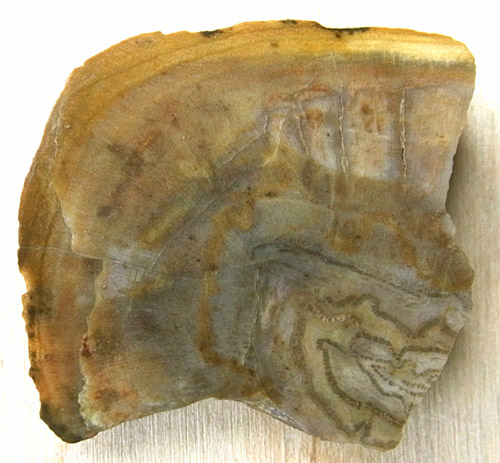
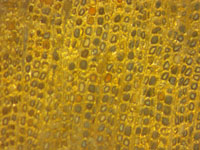 Fig.2:
Secondary wood as
the main constituent of the seed fern stem in Fig.1. Cell
sizes 80-100µm.
Fig.2:
Secondary wood as
the main constituent of the seed fern stem in Fig.1. Cell
sizes 80-100µm.
Fig.3, below: Sclerotic structure in the center
of the seed fern stem, detail of Fig.1.
Width of the picture 10mm.
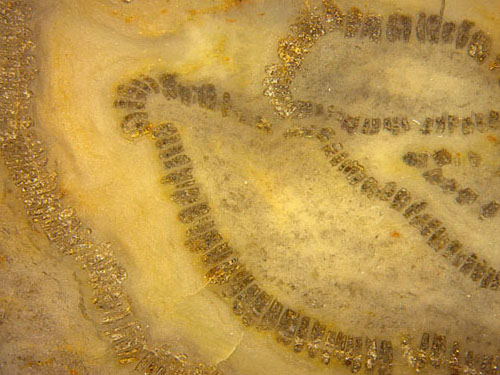
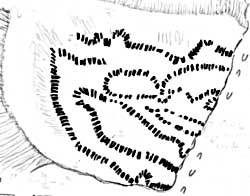
Fig.4: Sclerotic loops in the center of the
seed fern stem, detail of Fig.1, same scale, orientation of the
U-shaped components indicated on the right.
Obviously the center with several dark loops within a
seemingly structureless matrix is small compared to the area occupied
by the surrounding wood. Near the circumference the wood is degraded
and squeezed and possibly partially lost, hence the original radius of
the stem must have been larger.
The loops are the peculiar feature to be looked
at. The innermost loop is closed (not seen
on this cut face) so that one may assume that all the loops are closed
and hence are cross-sections of a tubular structure extending along the
stem. A discontinuity seen in the
outer loop is most probably due to rupture before silicification.
Every
loop consists of cross-sections of what seems to be separate
strands (Fig.5), neatly arranged side by side forming a chain, about 30
of them
for the small innermost loop and about 300 for the largest
loop. 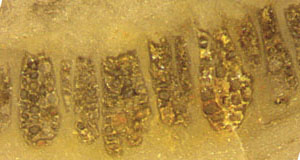
Fig.5: Cross-sections of sclerotic strands in the seed fern
center. Width of the picture 2mm.
Every
strand cross-section consists of what looks like sclerotic cells
arranged more or less orderly in one to four files of about 4 to 10
cells. The length of the files varies between 0.3 to 0.8mm.
The
ends of the strand sections are unequal: One end is more or less
rounded, the other one is more edgy as if something had been torn off,
hence the strand sections appear more or less U-shaped. All the “U”s of
one loop have got the same orientation with respect to the
loop: pointing either inward or outward. All the “U”s
of the
outermost
loop, for example, are oriented such that the open end of the U points
outward.
Not seen on this face is the changing connectivity of (some
of) the loops along the stem. The question arises how to relate the
loops to structures known from other seed ferns, and what purpose the
loops may have served. A clue may be provided by the observation that
largely decayed wood is vaguely seen in one place adjacent to the
outside of the outer loop. Very faint indications of the former
presence of attached wood are seen inside other loops, too. The
vanished wood seems to have been always attached to the upper side of
the "U"s.
By imagining the vanished secondary wood being restored, some
similarity with the "star rings" and larger components of Medullosa stellata
and Medullosa leuckartii
appears. (The structure and tissues of palaeozoic seed ferns and their
interpretation have been discussed in [4,5], where it appears that the
matter is rather complex.)
Considering that the outer wood of the present sample is well preserved
and the wooden components of the Medullosa
stems are usually so, too, their reduction to a few cell layers forming
some kind of sclerotic tubes, seen as loops in the present section,
poses a problem.
As one thinkable option, the small amount of
secondary wood of the strands within the pith was of no use to the
grown-up plant any more and therefore was left to degrade, with the
exception of the small initial fraction turned into sklerenchyma in
order to obtain a fibrous component with high tensile strength, which
would be advantageous for a vine-like growth habit.
Sample: found in 1994 at Pesterwitz near Freital, kept in
the own collection under Pe/6.
H.-J.
Weiss 2013
[1] R. Rößler:
Der versteinerte Wald von Chemnitz. Museum f. Naturkunde Chemnitz 2001.
[2] B.
Cotta: Die Dendrolithen in Bezug auf ihren inneren
Bau. Leipzig und Dresden 1832.
[3] O.
Weber, J.T. Sterzel: Beiträge zur Kenntnis der Medullosen,
Ber.
Naturwiss. Ges. Chemnitz 13(1896), 44-143.
[4] R.W.
Baxter: Some pteridosperm stems and fructifications with
particular reference to the Medullosae,
Annals Missouri Botanical
Garden 36(1949), 287-353.
[5] T.N.
Taylor, E.L. Taylor, M. Krings: Paleobotany, Acad. Press
2009.
|

|
 19 19 |

 19
19
 Fig.2:
Secondary wood as
the main constituent of the seed fern stem in Fig.1. Cell
sizes 80-100µm.
Fig.2:
Secondary wood as
the main constituent of the seed fern stem in Fig.1. Cell
sizes 80-100µm.



 19
19